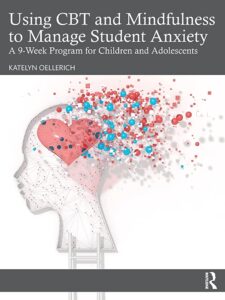Manage Student Anxiety with CBT & Mindfulness
Using CBT and Mindfulness to Manage Student Anxiety
By Katelyn Oellerich
(Routledge, 2023 – Learn more)
Reviewed by Kathleen Palmieri

How can mindfulness support CBT? “Mindfulness practice brings the mind back to the moment whenever it begins to wander. Thoughts are acknowledged but allowed to float past.” (page 21)
Using both CBT and Mindfulness, Oellerich has created a 9-week program for children and adolescents providing an overview of both practices. Her lessons encompass nine sessions – each building on what’s gone before. These lessons help students to become aware of their emotions and regulate them in several ways.

Worry is defined as “The mind is focused on something and continues to perseverate on that thought and get caught in the negative.” Anxiety is different as “People with anxiety tend to avoid situations where they may feel anxious; they experience intense fear, and they worry much more than is expected about typical stressors (Cleveland Clinic, 2017).” (page 2).
Oellerich then discusses physical, cognitive, and behavioral symptoms, showing the relationship between each state.
CBT and Mindfulness
Oellerich first focuses on Cognitive Behavioral Therapy, considering these main components in treatment:
• Supporting an awareness of what is occurring across emotions, thoughts, and behaviors.
• Recognizing and then reframing maladaptive thoughts to be more realistic and positive in nature.
• Assessing the situation for what is within our control (our actions) and what is outside of our control (the actions of others).
• Teaching and reinforcing the use of coping strategies that work to calm the mind and body.
Incorporating mindfulness to support CBT can be done in many ways. “People tend to work to cultivate mindfulness through a focus on breath work, movement, creativity, or visualization.” (page 22) Oellerich describes each focus and how it is utilized through practice.
“Pairing Mindfulness with CBT offers an opportunity to pay attention in the moment while considering what is most needed in order to support more positive thoughts, feelings, and behavior,” she writes on page 23.
The similarities and differences of mindfulness and CBT involve awareness of thoughts and their impact on the emotional and physical states. CBT is used to reframe thoughts, whereas mindfulness helps us be aware and accepting of thoughts and emotions. Both have been found to be useful in treating students with anxiety.
Targeting emotions
Chapter six (week two of the program) delves into the role of emotions – targeting, identifying and describing them. The chapter defines emotions such as sad, excited, worried, happy, and frustrated and offers strategies to help students feel calm. Moving from emotions to the relationship between thoughts and body (chapter seven, week three) helps students target physical cues related to anxiety, explore their thoughts when recognizing they are feeling anxious, and understanding the coping strategies they utilize. (page 47)
“Changing Thoughts and Working through Problems” in chapter 8, week 4, focuses on helping students analyze their thoughts relating to emotions, gain strategies to reframe negative thoughts, identify possible solutions to problems, and select the best option for themselves. (page 55)
This moves into “In and Out of Control/Coping Strategies” (chapter 9, week 5), helping students understand a problem, consider what power they have to change, and realize what is outside of their control. “Students also will be able to identify at least three stress reduction practices that they can utilize when feeling anxious.” (page 65)
Relationships
Week six, chapter 10, helps students to identify how people in their lives impact them, both negatively and positively. This lesson also helps students to identify changes they may need to make in relationships in order to create a positive well-being for themselves. (page 71). “Coping Strategies” are outlined in chapter 11 that help students to “explore different forms of stress reduction, including mindfulness, movement, creativity, and gratitude…(and) identify which forms of stress reduction are most beneficial.” (page 79).
Resources
Throughout this book/program, Oellerich provides case studies and clinical research. She includes continuing support strategies in the later chapters, offering emotional check-ins, daily mindfulness, and accommodations just to name a few. In chapter 15 there’s also support for the home including gratitude reflection, family mindfulness, and “what went well today.”
The appendices in the back of the book include a permission for participation in this program, a guardian questionnaire, a teacher questionnaire, a Pre/Post test, Weekly Assessment, and exercises that can be used throughout.
Support at school
Our current educational environment has become a primary source of support for students with anxiety. This program offers research proven methods and strategies to help manage anxiety, and goes further by incorporating the much-needed practice of mindfulness to help students find ways to build awareness and cope with their emotions, thoughts, and behaviors.
While this book offers a well-researched 9-week program for school-based mental health professionals, the case studies, definitions, methods and strategies shared can benefit all educators and practitioners.
See MiddleWeb articles by Katelyn Oellerich here.
Kathleen Palmieri is a National Board Certified Teacher and NBCT Professional Learning facilitator. She is a fifth grade educator in upstate New York who reviews and writes regularly for MiddleWeb. With a passion for literacy and learning in the classroom, she participates in various writing workshops, curriculum writing endeavors, and math presentations. Collaborating with colleagues and globally on Twitter https://twitter.com/Kathie_Palmieri and expanding on her education adventures at www.kathleenpalmieri.com are among her ongoing practices.






























